Citroen CX 1982 1.G Owners Manual
Manufacturer: CITROEN, Model Year: 1982, Model line: CX, Model: Citroen CX 1982 1.GPages: 394
Page 91 of 394
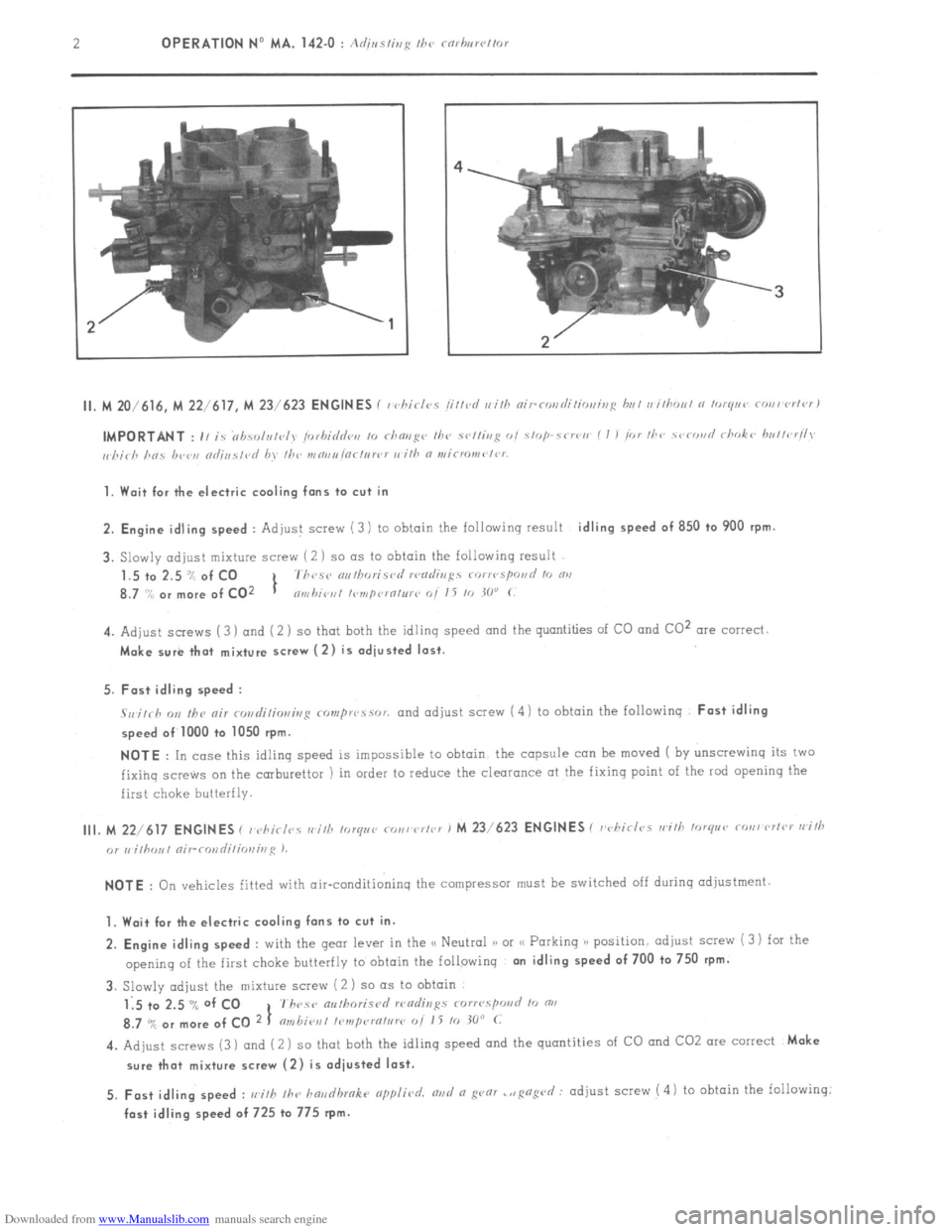
Downloaded from www.Manualslib.com manuals search engine 2 OPERATION No MA. 142-O : A
2. Engine idling speed
: Adjust screw (3) to obtain the following result idling speed of 850 to 900 rpm.
3. Slowly adjust mixture screw (2) so os to obtain the following result
1.5 to 2.5 % of CO
1 ‘, hiT<, “,, /horiscd r
4. Adjust screws (3) and (2 ) so that both the idlinq speed and the quantities of CO and CO2 are correct
Make surf that mixture screw (2) is odiusted last.
5. Fast idling speed :
Sa’itrh 012 Ihc nir rwdilim,h~g compr~~ssol: and adjust saew (4) to obtain the followinq Fast idling
speed of 1000 to 1050 rpm.
NOTE
: In case this idling speed is impossible to obtain the capsule can be moved ( by unscrewinq its two
fixihg
screws on the carburettor ) in order to reduce the clearance ot the fixing point of the rod opening the
first choke butterfly.
NOTE : On vehicles fitted with air-conditioninq the compressor must be switched off during adjustment
1. Wait for the electric cooling fans to cut in.
2. Engine idling speed
: with the gear lever in the o Neutral >) or /( Parking >a position. adjust screw (3) for the
opening of the first choke butterfly to obtain the followinq
an idling speed of 700 to 750 rpm.
3. Slowly adjust the mixture SCEW (2 ) so as to obtain
115 to 2.5 “/, of CO ‘l’h~sc anlhorisrd rcndin~ rorrc,spoad Iv m,
8.7 ‘7,
or more of CO 21 m~bt~wi I ~cnipw7tnr~~ 01 I i k, 30” (.
4. Adjust screws (3) and (2) so that both the idling speed and the quantities of CO and CO2 are correct Make
sure that mixture screw (2) is adiusted last.
5. Fast idling speed : wilh /he hnsdbmkr npplic,d, furl cz SPOT ..,gayt>d : adjust screw ! 4) to obtain the following;
fast idling speed of 725 to 775 rpm.
Page 92 of 394
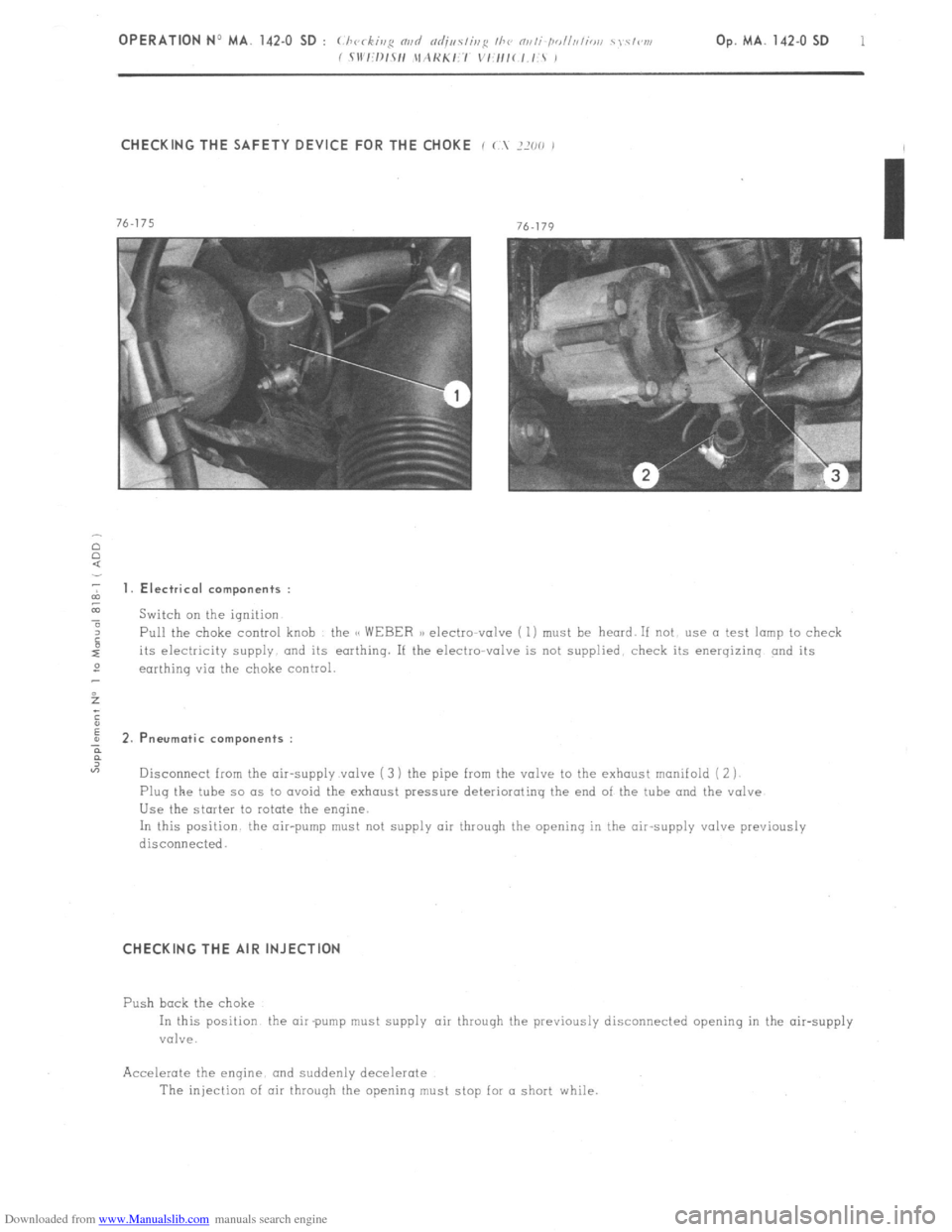
Downloaded from www.Manualslib.com manuals search engine OPERATION No MA. 142-O SD : (I k’ II c ,r,g m,d or/j,,r/ii,,~ /he m/i /dllllior, 5, Cl<‘,,i Op. MA. 142-O SD 1
f SIi’III)ISH \IAKKl:‘/ ,‘1,,,( 1.1’) ,
CHECKING THE SAFETY DEVICE FOR THE CHOKE i ( ?XO ,
2 1. Electrical components :
z
a Switch on the ignition
4 Pull the choke control knob the CC WEBER a) electto-valve ( 1) must be heard. If not use a test lamp to check
its electricity supply and its earthing. If the electro-valve is not supplied. check its energizinq and its
2
earthinq via the choke control.
5
;
E
; 2.P neurotic components :
?
“7
Disconnect from the air-supply valve ( 3 ) the pipe from the valve to the exhaust manifold ( 2 j
Plug the tube so as to avoid the exhaust pressure deteriorating the end of the tube and the valve
Use the starter to rotate the engine.
In this position the air-pump must not supply air through the opening in the air-supply valve previously
disconnecied.
CHECKING THE AIR INJECTION
Push bock the choke
In this position the air pump must supply air throuqh the previously disconnected opening in the air-supply
valve.
Accelerate the enqine. and suddenly decelerate
The injection of air through the openinq must stop for a short while.
Page 93 of 394
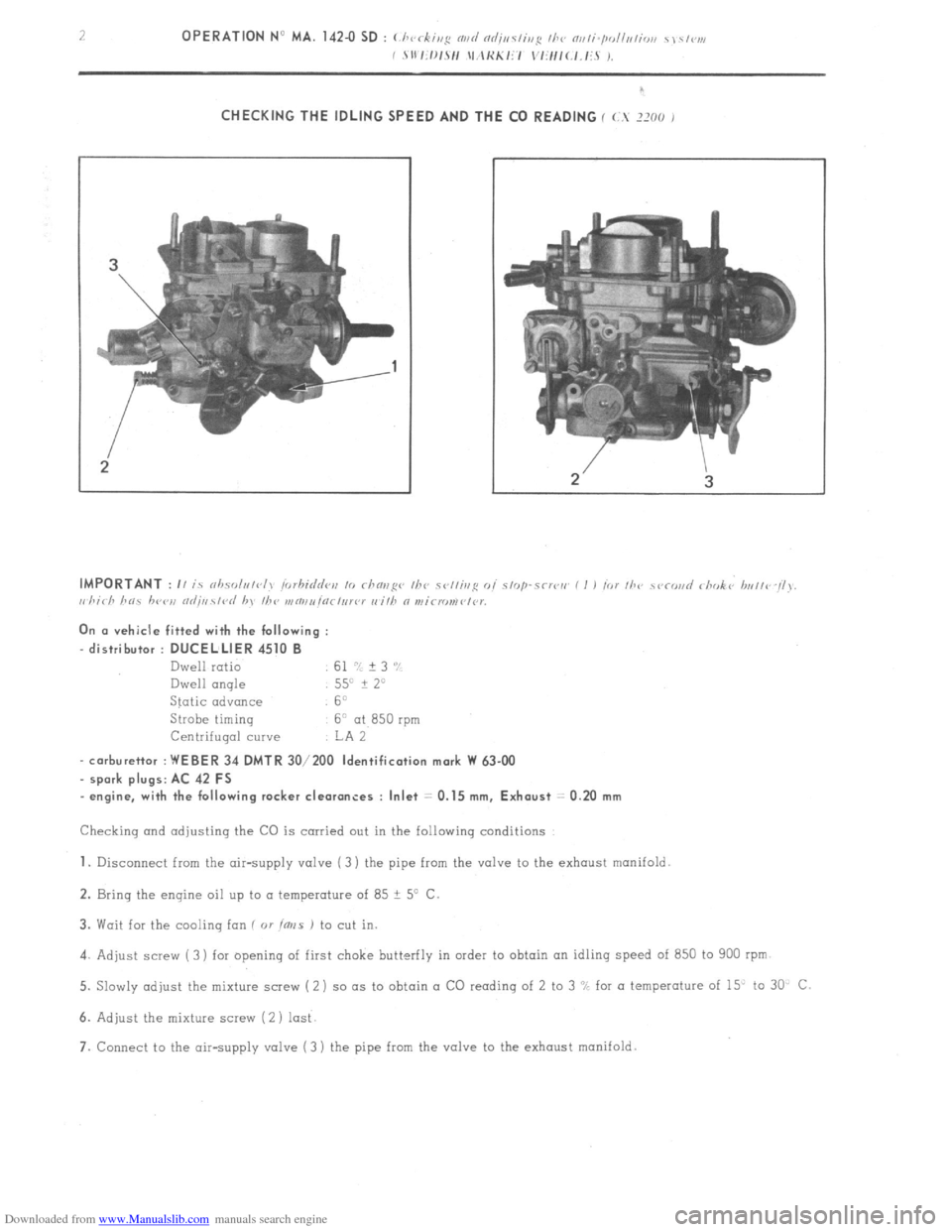
Downloaded from www.Manualslib.com manuals search engine 2
OPERATION No MA. 142.0 SD : (./ )I c ,,,s m,d nd;,,s/is~~ /A? Ni/li-/Joll,lli,,ill I \/i’V, b’
/ Sll l:l~/sl1 lI.\KKI:I v1:/1/c l.JT I,
CHECKING THE IDLING SPEED AND THE CO READING I (.. JXO J
On cr vehicle fitted with the following :
-distributor : DUCELLIER 4510 B
Dwell ratio 61 7: + 3 ‘Y
Dwell angle 550 + 2”
Static advance 6”
Strobe timinq
6” at 850 rpm
Centrifuqal cuwe IA 2
- carburettor : WEBER 34 DMTR 30/200 Identification mark W 63-00
spark plugs: AC 42 FS
- engine, with the following rocker clearances : Inlet = 0.15 mm, Exhaust = 0.20 mm
Checking and adjusting the CO is carried out in the following conditions
1. Disconnect from the air-supply valve ( 3) the pipe from the valve to the exhaust manifold
2. Bring the engine oil up to a temperature of 85 ? 5’ C
3. Wait for the cooling ion ( 01
ims J to cut in.
4. Adjust screw ( 3) for opening of first choke butterfly in order to obtain on idling speed of 850 to 900 rpm
5. Slowly adjust the mixture screw (2) so (IS to obtain a CO reading of 2 to 3 “L for a temperature of 15” to 30 C
6. Adjust the mixture screw (2 ) lost
7. Connect to the air-supply valve (3 ) the pipe from the valve to the exhaust manifold.
Page 94 of 394
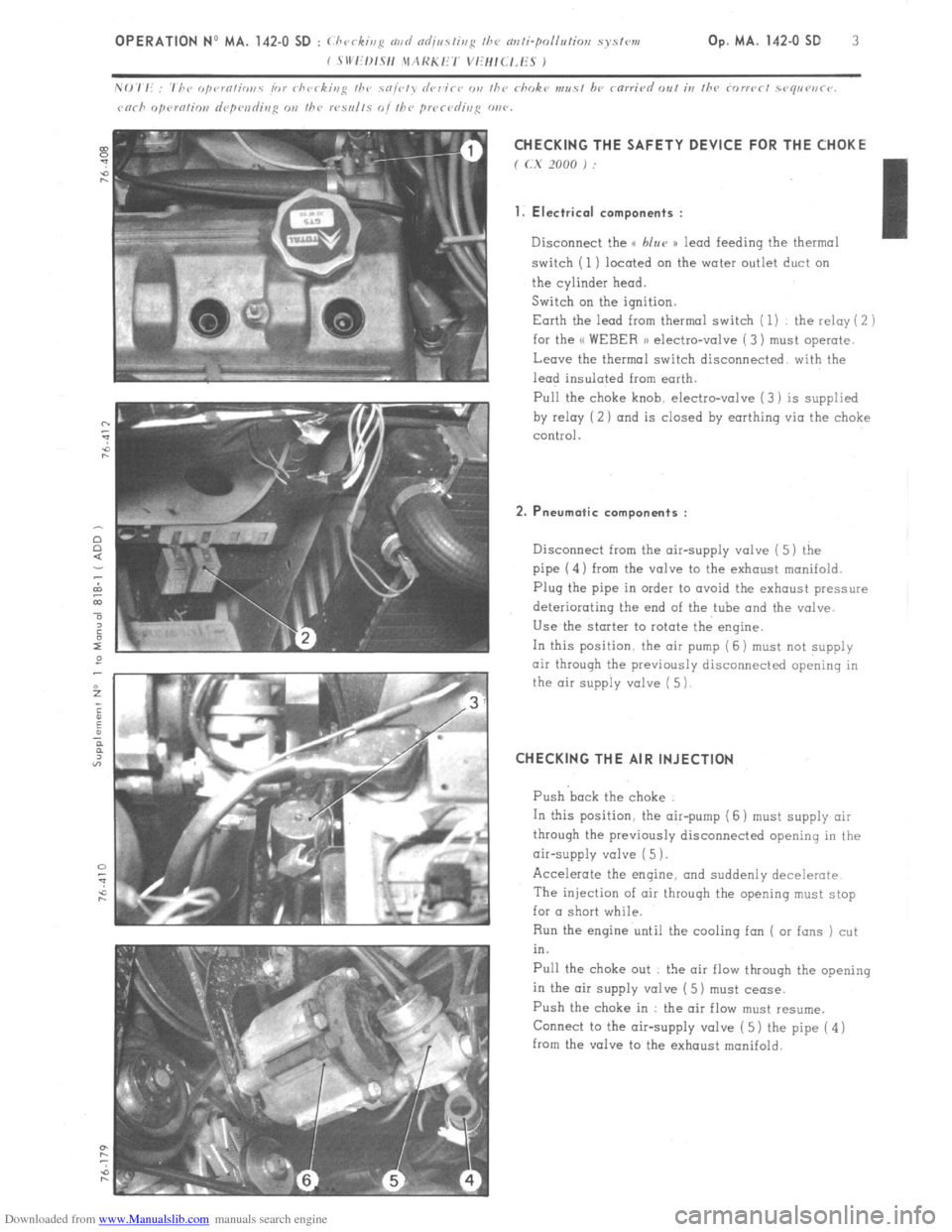
Downloaded from www.Manualslib.com manuals search engine CHECKING THE SAFETY DEVICE FOR THE CHOKE
f (.X 2000 j :
1. Electrical components :
Disconnect the u blur )) lead feeding the thermal
switch (1) located on the water outlet duct on
the cylinder head.
Switch on the ignition.
Earth the lead from thermal switch ( 1) the relay ( 2 )
for the << WEBER 1) electro-valve ( 3) must operate.
Leave the thermal switch disconnected with the
lead insulated from earth.
Pull the
choke knob. electro-valve (3) is supplied
by relay (2 ) and is closed by earthing via the choke
control.
2. Pneumatic components :
Disconnect from the air-supply valve ( 5) the
pipe (4) from the valve to the exhaust manifold.
Plug the pipe in order to avoid the exhaust pressure
deteriorating the end of the tube and the valve
Use the starter to rotate the engine.
In this position. the air pump (6 j must
not supply
air through the previously disconnected opening in
the air supply valve ( 5)
CHECKING THE AIR INJECTION
Push back the choke
In this position. the air-pump (6 ) must supply air
through the previously disconnected opening in the
air-supply valve ( 5 1.
Accelerate the engine, and suddenly decelerate
The injection of air throuqh the opening must stop
for a short while.
Run the engine until the cooling fan ( or fans ) cut
in.
Pull the choke out : the air flow through the opening
in the air supply valve ( 5) must cease.
Push the choke in : the air flow must resume.
Connect to the air-supply valve ( 5) the pipe ( 4 )
from the valve to the exhaust manifold.
Page 95 of 394
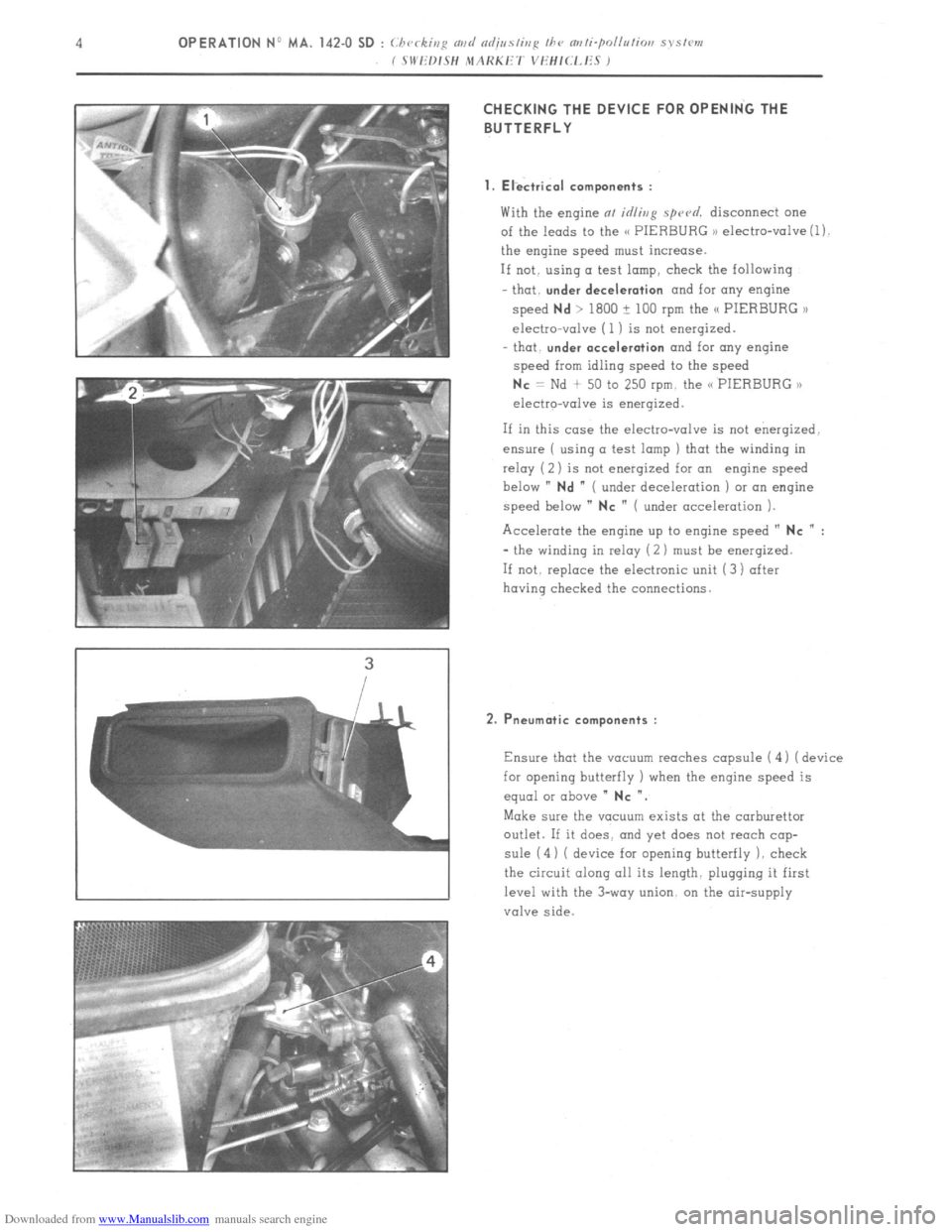
Downloaded from www.Manualslib.com manuals search engine CHECKING THE DEVICE FOR OPENING THE
BUTTERFLY
1. Electrical components :
With the engine at idling spu~d. disconnect one
of the leads to the C< PIERBURG ,) electro-valve (1).
the engine speed must increase.
If not. using a test lamp, check the following
that.
under deceleration and for any engine
speed
Nd > 1800 ? 100 rpm the /C PIERBURG >l
electro-valve (1 ) is not energized.
- that.
under acceleration and for any engine
speed from idling speed to the speed
Nc = Nd + 50 to 250 rpm. the C< PIERBURG ,,
electro-valve is energized.
If in this case the electro-valve is not energized.
ensure ( using a test lamp ) that the winding in
relay ( 2) is not enerqized for an engine speed
below ”
Nd ” ( under deceleration ) or an engine
speed below ”
NC ” ( under acceleration ).
Accelerate the engine up to engine speed ”
NC n :
- the winding in relay (2 ) must be enerqized.
If not. replace the electronic unit (3) after
having checked the connections.
2. Pneumatic components :
Ensure that the vacuum reaches capsule ( 4 1 ( device
for opening butterfly ) when the engine speed is
equal or above ”
NC “.
Make sure the vacuum exists at the carburettor
outlet. If it does. and yet does not reach cap-
sule (4) ( device for opening butterfly 1. check
the circuit along all its length. plugging it first
level with the 3-way union. on the air-supply
valve side.
Page 96 of 394
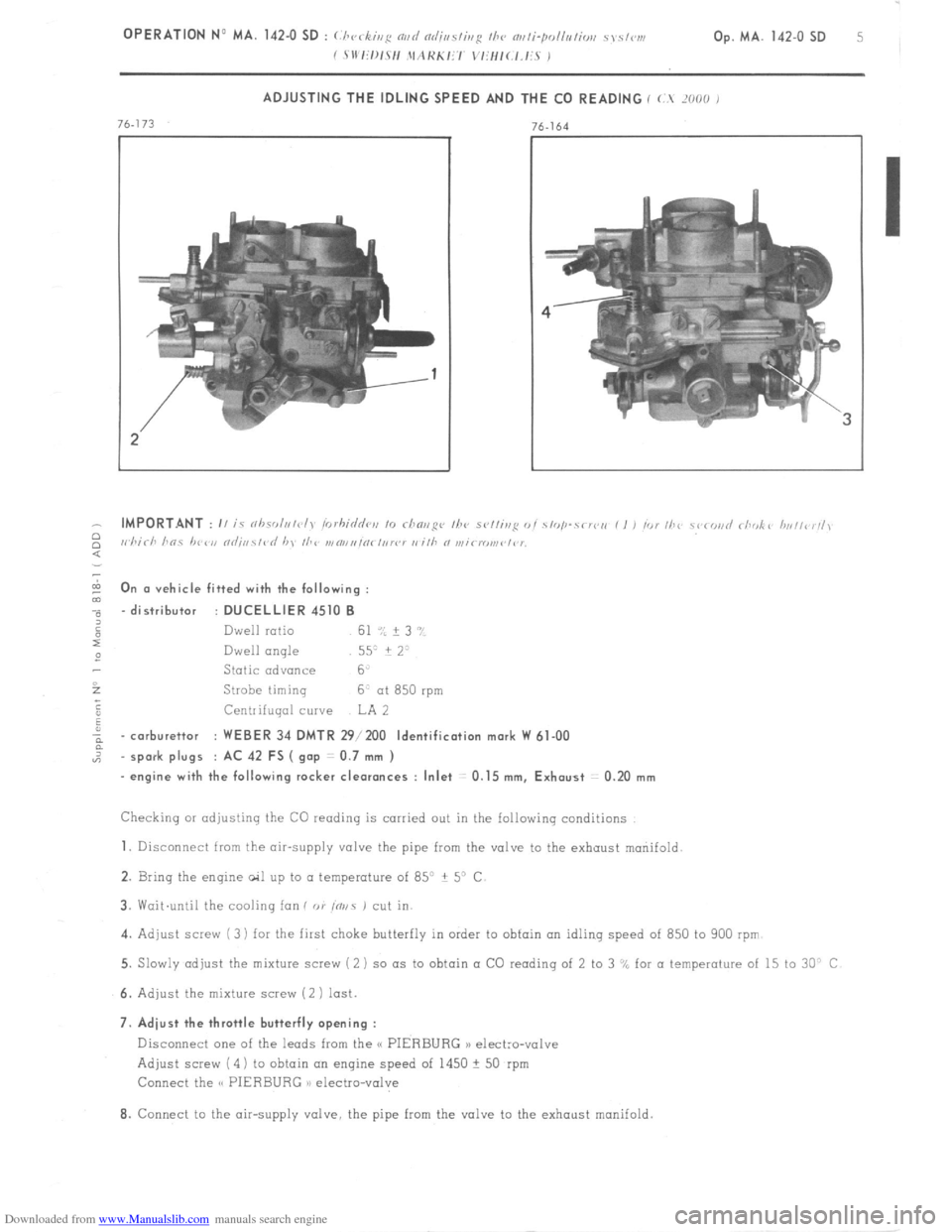
Downloaded from www.Manualslib.com manuals search engine OPERATION No MA. 142-O SD : (i ‘CC ,ii:: md nr/;,,sfinji //I<, “~,ti.pOlllLliol, .S,Sl~l,, k’
c s 11’1:/~12/1 ,\lAHKli’/ “,iH,(.,.li.S , Op. MA. 142-O SD 5
ADJUSTING THE IDLING SPEED AND THE CO READING ( (.. ‘01~0 I
- IMPORTANT : II i nhsr,l,,/<~l, irirhi<&,, ,o rhnri~q~, /he sv//ing o, .Y,<,,I-r< lo,, , I , ,o, //a~ ~i.
2 I, hirh hns /,<,,‘I, “
: 0
m n (I vehicle fitted with the following :
m
-.
“, - distributor : DUCELLIER 4510 B
6
Dwell ratio 61 ‘:: ? 3 ‘,
x
2 Dwell angle
557 i 2=
Static advance 6
i
Strobe liming 6. at 850 rpm
;
F Centrifugal curve LA 2
a
a - carburettor : WEBER 34 DMTR 29/200 Identification mark W 61-00
5
“2 - spark plugs : AC 42 FS ( g.ap : 0.7 mm )
- engine with the following rocker cleoronces : Inlet 0.15 mm, Exhaust : 0.20 mm
Checking or adjusting the CO reading is carried out in the following conditions
1. Disconnect from the air-supply valve the pipe from the valve to the exhaust mariifold.
2. Bring the engine ail up to a temperature of 85” ? 5” C.
3. Wait.until the cooling fan f or fnvs 1 cut in.
4. Adjust screw ( 3) for the first choke butterfly in order to obtain on idling speed of 850 to 900 rpm
5. Slowly adjust the mixture screw (2 ) so as to obtain a CO reading of 2 to 3 “A for a temperature of 15 to 30” C
6. Adjust the mixture screw (2 1 last.
7. Adiust the throttle butterfly opening :
Disconnect one of the leads from the S( PIERBURG n electro-valve
Adjust screw (4) to obtain on engine speed of 1450 + 50 rpm
Connect the S< PIERBURG n electro-valve
8. Connect to the air-supply valve, the pipe from the valve to the exhaust manifold.
Page 97 of 394
![Citroen CX 1982 1.G Owners Manual Downloaded from www.Manualslib.com manuals search engine ELECTRONIC FUEL INJECTION
OPERATION No MA. IE. 144-00 : <:hnrcrctwistics o/ the H I,-]c~trouic’a clcctrovic Op. MA. IE. 144-00 1
fuel iujrc Citroen CX 1982 1.G Owners Manual Downloaded from www.Manualslib.com manuals search engine ELECTRONIC FUEL INJECTION
OPERATION No MA. IE. 144-00 : <:hnrcrctwistics o/ the H I,-]c~trouic’a clcctrovic Op. MA. IE. 144-00 1
fuel iujrc](/img/9/4131/w960_4131-96.png)
Downloaded from www.Manualslib.com manuals search engine ELECTRONIC FUEL INJECTION
OPERATION No MA. IE. 144-00 : <:hnrcrctwistics o/ the H I,-]c~trouic’a clcctrovic Op. MA. IE. 144-00 1
fuel iujrctian swtem.
I
a L- JETRONIC H
System
Page 98 of 394
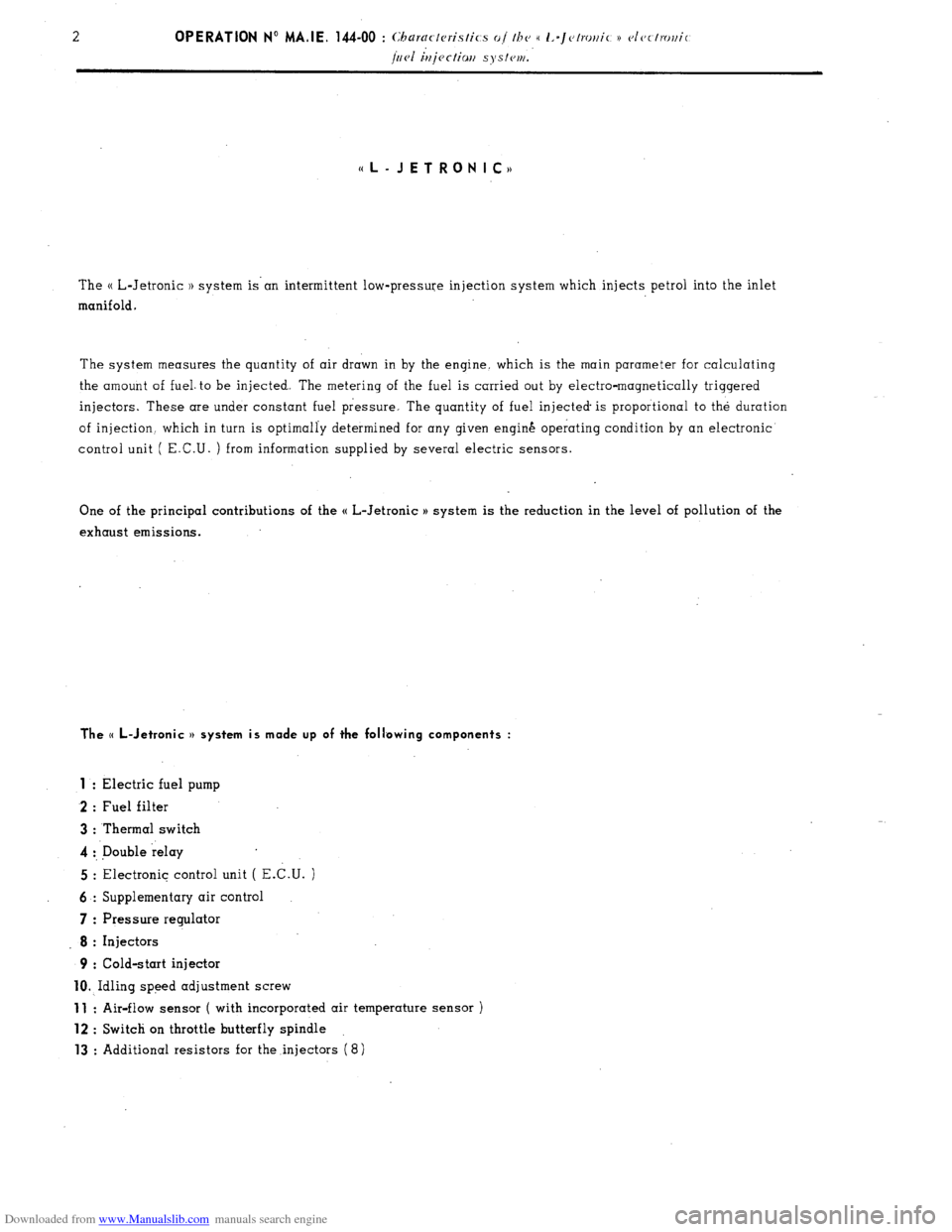
Downloaded from www.Manualslib.com manuals search engine 2
OPERATION No MA.IE. 144-00 : Chtiractcristics o/ the e 1,-Jc,tror,ic H clcctroltic
fire1 injc ctiwt systettt.
((L-JETRONIC,,
The H L-Jetronic 1) system is’an intermittent low-pressure injection system which injects petrol into the inlet
manifold.
The system measures the quantity of air drawn in by the engine. which is the main parameter for calculating
the amount of fuel. to be injected. The metering of the fuel is carried out by electro-magnetically triggered
injectors. These are under constant fuel pressure. The quantity of fuel injected is proportional to the duration
of injection. which in turn is optimally determined for any given engin& operating condition by an electronic
control unit ( E.C.U. ) from information supplied by several electric sensors.
One of the principal contributions of the H L-Jetronic H system is the reduction in the level of pollution of the
exhaust emissions.
The (( L-Jetronic v system is made up of the following components :
1
: Electric fuel pump
2 : Fuel filter
3 : Thermal switch
4 :, Double relay
5 : Electronic control unit ( E.C.U. )
6 : Supplementary air control
7 : Pressure regulator
8 : Injectors
9 : Cold-start injector
10. Idling speed adjustment screw
11 : Air-flow sensor ( with incorporated air temperature sensor )
12 : Switch on throttle butterfly spindle
13 : Additional resistors for the injectors (8)
Page 99 of 394

Downloaded from www.Manualslib.com manuals search engine OPERATION No MA. IE. 144-00 : Cbtirnctcristics oj ~hc /’ I,-jetrorlic )) rlectronic
/he1 iujcctim systvrn. Op. MA.IE. 144-00 3
GENERAL LAYOUT
L 14-19
Page 100 of 394
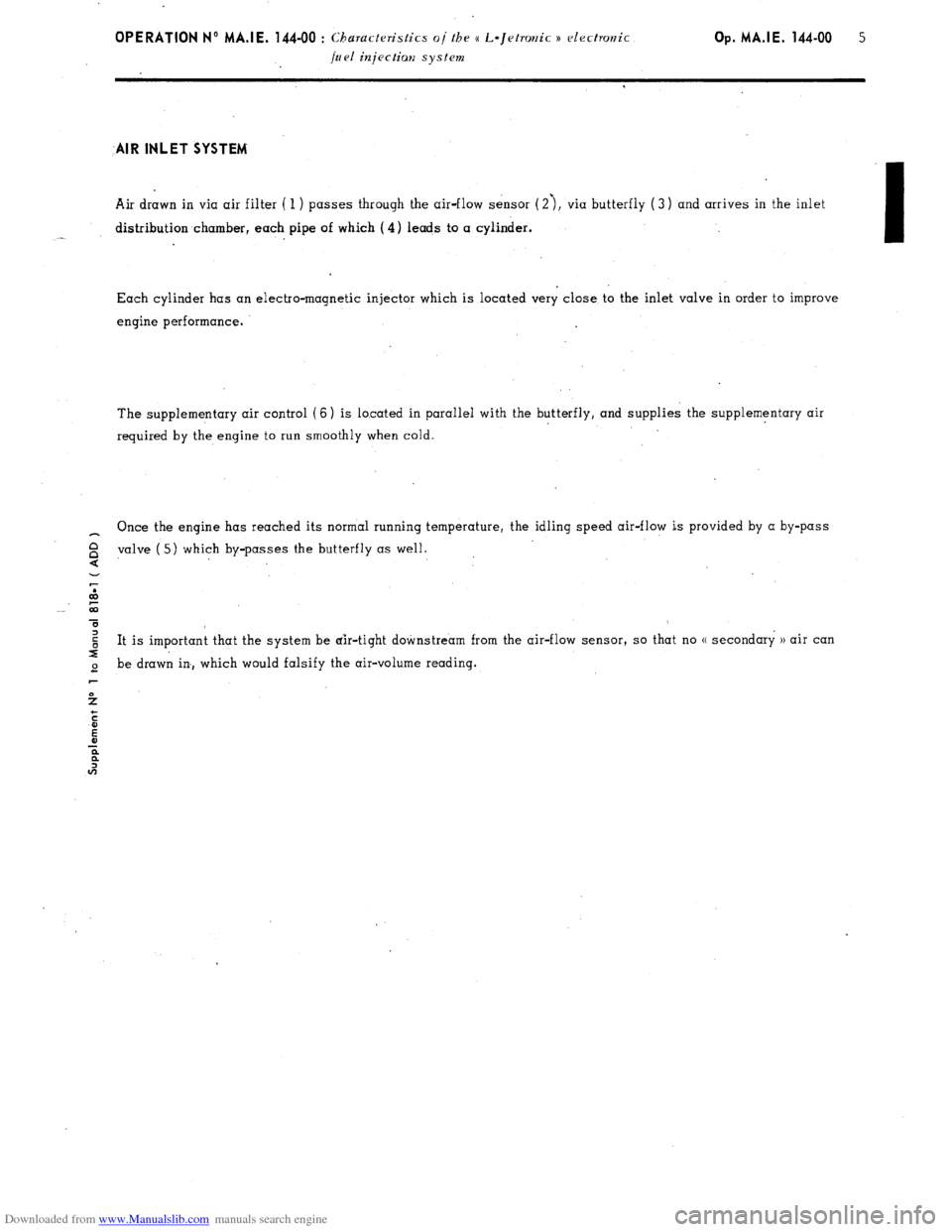
Downloaded from www.Manualslib.com manuals search engine OPERATION No MA.IE. 144-00 : Chu~acte~istics of the (( L-Jetronic n electronic
fuel injectiari system Op. MA.IE. 144-00 5
-AIR INLET SYSTEM’
Air drawn in via air filter ( 1 ) passes through the air-flow sensor (2’), via butterfly ( 3) and arrives in the inlet
distribution chamber, each pipe of which (4) leads to a cylinder.
-
‘I
Each cylinder has an electro-magnetic injector which is located very close to the inlet valve in order to improve
engine performance.
The supplementary air control (6) is located in parallel with the butterfly, and supplies the supplementary air
required by the engine to run smoothly when cold.
_ Once the engine has reached its normal running temperature, the idling speed air-flow is provided by a by-pass
valve
$ ( 5) which by-passes the butterfly as well.
.
2
co
T
$ It is important that the system be air-tight downstream from the air-flow sensor, so that no (( secondary )) air can
I
2 be drawn in, which would falsify the air-volume reading.